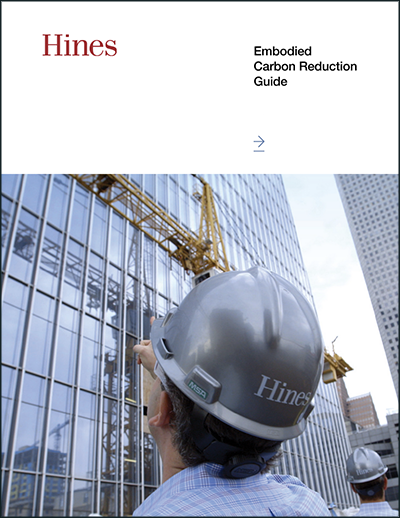Hines embeds environmental stewardship into aspects of building development, engineering, and management. We meet climate challenges with data-driven strategies and innovative, scalable solutions to reduce emissions, increase efficiency, and manage risk across our assets.

Environmental Stewardship
Building Performance and Operational Carbon
We are committed to optimizing performance and minimizing operational carbon at Hines buildings worldwide.
Our teams monitor and manage energy consumption, integrate renewable energy sources, and implement robust water-efficiency and waste-management strategies across our assets. To understand and reduce our negative environmental impacts, we continuously improve data collection and analysis, and benchmark success through leading green building certifications, which underscore the quality and performance of our assets.
Green Building Certifications
Green building certifications help us meet tenant and investor requirements. Many Hines assets already have at least one certification, and we are conducting gap analyses to assess the feasibility of achieving them portfolio wide.
164M+ square feet certified under green and healthy building certifications, and energy ratings1






Advancing Portfolio Efficiency
The impact of energy use on the environment is one of the biggest challenges facing our industry and the global environment. To address it, we are conducting assessments and creating project plans to move our assets toward more efficient operations.
Our Targets2
- Hines’ SBTi-approved targets align with a 1.5°C pathway
- Net zero operational carbon by 2040
- By 2030 we commit to reducing absolute greenhouse gas emissions across
- Scope 1 & 2 by 42% from a 2021 base year
- Scope 3 by 42% from use of sold products and downstream leased assets within the same timeframe
To reach our targets, we implement custom plans integrating key tactics. These include:
- Enhancing operational efficiency to lower energy demand
- Increasing reliance on alternative energy sources
- Implementing circular systems to optimize resource and energy efficiency
- Progressively electrifying systems while shifting to more efficient energy sources
- Collaborating with our tenants to support broader environmental goals
We continue to develop new strategies and proprietary tools to help Hines teams address the environmental impacts at our assets.
Materials Circularity & Embodied Carbon
We leverage circular principles to reduce waste and minimize emissions.
In our development and refurbishment projects, we consider environmental impacts at the product, construction, and decommissioning stages to ensure the responsible use building materials and equipment as well as transportation and demolition.
Reducing Environmental Footprint
We provide Hines teams and the broader industry with tested solutions for minimizing environmental impacts through sustainable design and construction practices.
Climate and Nature Risk
Climate considerations are embedded into our firm’s risk management and strategic decision-making processes.
To improve climate resilience across our portfolio, we identify climate-related risks that could negatively impact investment value and asset operations, and social and environmental health, and create risk management plans to address them.
Codifying Our Climate Strategy
Our TCFD-aligned Climate Strategy Report provides transparency and serves as our playbook for managing and mitigating physical and transition risks at Hines assets.
Nature
We are creating a firm-wide nature policy strategy aligned with the Taskforce on Nature-related Financial Disclosures (TNFD) to guide actions that support biodiversity and advance nature-based sustainability initiatives at our assets.
To learn more about our Sustainability Certifications, visit: Sustainability Certification Definitions
Footnotes:
1 Includes all certifications across the entire Hines portfolio, encompassing both the equity and third-party assets as of December 31, 2024.
2 There is no guarantee Hines will achieve all of its sustainability objectives.


